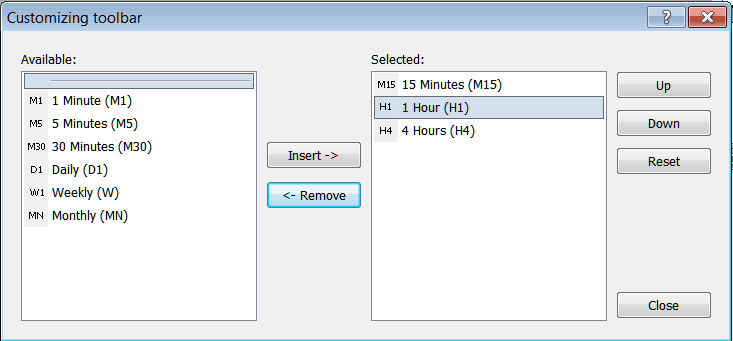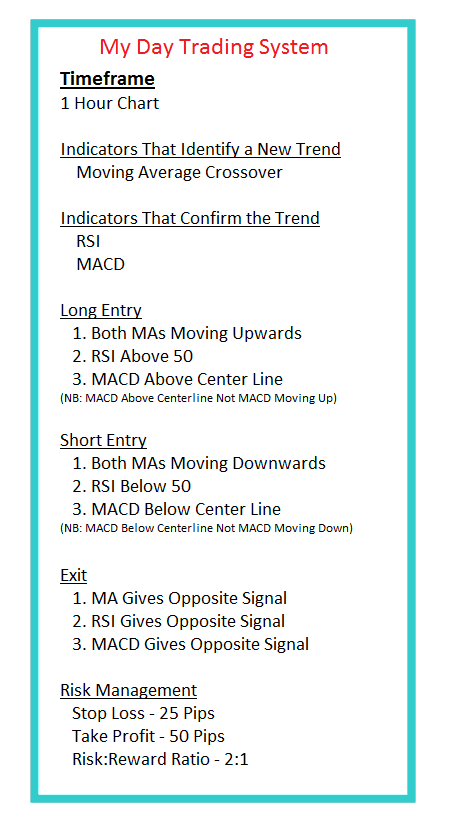Developing a System: Indicator Based Stock System
A trading strategy means a list of rules for handling trades. You follow them to enter or leave positions. Build a system by mixing two or more indicators.
For instance, pair the Stochastics Indicator with other tools to build a trading plan. In this case, the stochastics oscillator joins forces with the indicators listed below to shape the system.
- RSI
- MACD indicator
- MAs indicators
Examples - MetaTrader 4 Template Trading Strategy Example

Making a System - Trading Trading Strategy Example Template
Therefore, the central question becomes: how can a trader design functional trading strategies, akin to the system example provided, and formalize their associated entry/exit criteria? To document system rules, proceed by following the subsequent instructions.
Seven steps to developing a technical indicator based system
To come up with these set of trade rules we make use of the following 7 guidelines.
1. Choose and Select your Timeframe
The amount of time you, as a trader, want to devote to trading determines this initial step. You may choose to spend many hours at a desktop computer, analyzing tiny chart time intervals, or you may choose to create your charts using larger chart time intervals once or twice daily. What kind of trader you are will largely determine which chart time frame you choose or choose.

Time Frames on MT4 Software Platform
Test your trading strategy across time frames. See its results. Choose the best one for accuracy and profits.
2. Choose technical indicators to spot a new market trend
The goal of a trader is to get into the trade as early as possible & take maximum advantage of price moves.
One of the common ways to spot a new market trend as fast as possible is to use MAs Trading Indicator. A simple strategy is to use a MA cross over trading method which will spot a new opportunity at its earliest stage.
MA Cross over Method and Technique

Sell signals and Buy signals generated from the Moving Average Cross-Over Trading Method.
3. Choose supplementary technical indicators to affirm the prevailing market trend.
Once you spot a new market trend, use extra indicators to check entry signals. They will confirm if it's time to act or warn against false moves.
To confirm the signals we use RSI & Stochastic Oscillator Technical indicator.

RSI Indicator and Stochastic Trading Indicator System
4. Finding indices entry and exit points
Once you've picked indicators so that one shows a signal and another backs it up, then it's time to start trading on the market.
Jump into a trade once the signal confirms after the candle ends.
Aggressive traders initiate a trade position immediately, without waiting for the current price bar to conclude.
Other traders wait for the current price candlestick to close, then start the trade if the trade setup has not changed and the signal is still good. This way is more careful and stops extra false starts and quick changes in indices.
Generating Trade Signals - how to Generate Signals.

Generating Signals
For exits, a trader can either set an amount that they want to make per trade or use technical tools that help to set profit goals like Fib expansion tool or set a protective stop loss order depending on the market price volatility at any specific time. Alternatively a trader can exit when the indicators gives a trading signal in the opposite market trend signal.
When opening a new trade it's always key to calculate in advance how much you're willing to lose if the trade transaction moves against you. Although the objective is to develop the best system in world, losses are inevitable & therefore being ready to tell where you will give up & cut your losses before beginning a trade is very important.
5. Calculate risks in each setup
When you're trading indices, always calculate your risk before placing a trade. Serious traders look for a risk-to-reward ratio of at least 2:1.
If you use a high risk : reward ratio like 2:1, you significantly improve your chances of becoming profitable in the long run.
The Risk-Reward Chart below portrays you how:

Indices Money Management Risk:Reward Chart - Sample Template Trading Strategy
In the first risk-reward examples, a 50% win rate still nets $10,000 profit. Check more on this in indices money management: MT4 Template Rules and Index Equity Techniques with Trading Strategy Examples.
Before starting a new index trade, set the exit point if it loses. Some traders pick Fib retracement levels and support or resistance spots. Others set a fixed stop loss after opening the trade position.
6. Write down the systems indices rules and follow them
A Trading Strategy consists of a defined set of rules that guide your trade management.
The key thing here is simple: you need a set of trading rules, and you actually have to stick to them. If you can't follow your own rules, you don't really have a strategy in the first place.
The subsequent trading systems guide provides an example of how to apply the aforementioned steps to create your own online Indices system:
Next lesson: Sample rules for writing trading systems.
7. Practice on a Practice Account
You need plenty of trades to see your system's real profit potential.
Once you as a trader have your indices system rules written, it's time to test & improve your trade system by using it on a practice account.
Open a complimentary demo account and implement your strategy to evaluate its effectiveness.
It is strongly advised to commence trading using a simulation or practice account, dedicating at least one to two months to gain familiarity and build experience regarding the dynamics of market operations.
Once you begin to generate substantial profits in your demo account, you can consider transitioning to a live account and start trading with real funds.
Get More Courses and Topics:
- Adding NKY225 to the MT4 Mobile Trading Platform
- Analysis of the Moving Average Envelope Index Indicator
- US500 Training Tutorials for Advanced Market Insights
- Trading the SX 50 Indices Strategy
- Which Broker to Use for Stock Indices Trading SMI20
- Stochastic Technical Indicator Stock Index Trading Strategy
- A Look at the 3 Main Types of Index Charts
- Example of a Written Stock Index Trade Schedule
- How to Add the RSI (Relative Strength Index) Indicator to Stock Index Charts
- Bollinger %B or %b Index Technical Indicator Analysis

